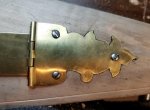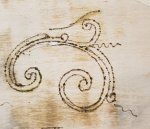Darkhorse
Senior Member
Here is a photo of a finished forearm from the muzzle. This is a good example, if you do it just like this your rifle will look fine. If it is flattened instead of being well rounded it will look slabsided.
I would have filed it straight from the ramrod rails to the curve, cutting out that little bit of sorta round material on the bottom sides. Then blend it with the top radius with blocked sandpaper. I think that would make the shape of the forearm more prominent.
JMHO
I would have filed it straight from the ramrod rails to the curve, cutting out that little bit of sorta round material on the bottom sides. Then blend it with the top radius with blocked sandpaper. I think that would make the shape of the forearm more prominent.
JMHO






 Nope no hiding it. This is the pretty side. I'll just have to ugly those deer to death with it.
Nope no hiding it. This is the pretty side. I'll just have to ugly those deer to death with it. 





